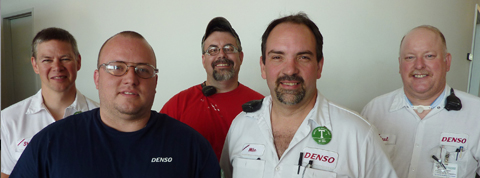Fluxing Their Muscles

A little teamwork and swift action saved DENSO Manufacturing Michigan (DMMI) $341,000 per year. Here’s how.
The It Takes Two kaizen team at DMMI was looking for something to improve, and they quickly zeroed in on a machine on the RS evaporator line that was wasting flux. And no, we’re not talking about a flux capacitor. Flux is a white powder-like substance that is used to seal parts, like evaporators. And the saying at DMMI goes, “Flux wasted is money wasted.” So, this machine was ripe for improvement.
The Challenge
The machine sprayed three lanes of staggered parts with flux. Due to the wide spray area needed to cover the three lanes of “parts traffic,” the machine used a specific type of fan nozzle that effectively sprayed not just the parts, but almost everything else inside the machine.
This was problematic because, inside the machine, a photo eye detected when the parts were in position. When the eye saw they were in position, it was spraying time. However, the photo eye was getting sprayed with flux. This caused the machine to spray when parts weren’t in position. And due to the staggered parts, sometimes one lane was targeted, but three lanes were sprayed.
Going for the Goal
The team’s goal was to take the machine from three lanes to one. But they would need to use a different type of nozzle with a more focused, controllable spray instead of the monster nozzle that hosed everything in sight.
So, the team embarked on a mission to find the right nozzle for the job, and after extensive research, they chose a nozzle that sprayed in a focused cone. But that created another roadblock. In order to use this nozzle, the flux had to be pressurized. The existing fan-style nozzle was pumped instead of pressurized. And on top of that, the manufacturer of the machine wasn’t even sure it was possible to pressurize this type of flux.
Luckily, the team didn’t let that discourage them. After an exhaustive amount of testing, they proved that the flux could be pressurized.
Results
The machine was modified more than a year ago based on the It Takes Two team’s research and testing. And it’s already saving DMMI $341,000 per year. Not to mention, on this machine, the production ratio is up 20 percent, and flux usage is down 87 percent.The team is now working on a solution to cross-line this to other presses in the RS Evaporator area, and the Condenser area is also looking into adopting a similar technology.
They didn’t do it alone. The team thanks their upper management for their full support and the Machine Finishing group for being extremely helpful throughout the whole process.
